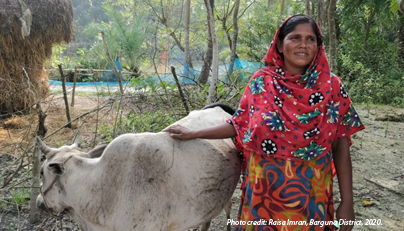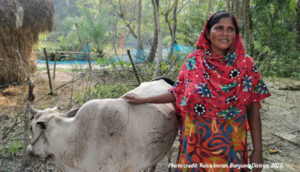
By Mahbuba Nasreen and Raisa Imran Chowdhury, GRRIPP-South Asia, Bangladesh

South Asian countries are highly susceptible to natural and human-induced hazards due to multiple factors, including its geophysical location and land characteristics. The mechanisms for disaster risk reduction (DRR) in South Asia have historically been shaped by colonial inheritances that put the interests of the ruling elites above those of the underprivileged groups who are most susceptible to the effects of disasters (Attallah, 2016). In order to decolonise DRR systems, it is necessary to question and change existing power dynamics while advancing inclusive and equitable approaches to DRR. The history and context of postcolonial DRR in South Asia are intricate. Several nations in South Asia were colonised by the European powers, leaving a legacy of unequal power relations and a history of exploitation (Carrigan, 2015). The region’s development and disaster preparedness have both been significantly influenced by this history. In South Asia, postcolonial DRR is a strategy that aims to acknowledge and address the historical effects of colonialism as well as the larger social, economic, and political elements that influence disaster risk. To provide a more comprehensive approach to DRR, it highlights the value of community involvement and local expertise in efforts to reduce disaster risk (Anthony et al., 2021).
Recognising the value of local knowledge and indigenous practices is one is of the most important facet of postcolonial DRR in South Asia. Local communities often have their own systems and processes for managing hazards and reduce risks. These techniques frequently draw from traditional wisdom and processes that have been handed down through the years (Carrigan, 2015). Postcolonial DRR acknowledges the significance of these methods and works to incorporate them into larger initiatives for reducing disaster risks. Additionally, in such an approach, there is a stronger focus on community involvement and empowerment. This entails giving local communities a voice in decision-making and making sure their voices are heard. This approach acknowledges that local communities are often the first to respond in the event of a disaster and that they have invaluable information and experience that may aid larger DRR efforts (Gupta & Sharma, 2006).
To resist against the hardships that its residents routinely face, the area has created disaster prevention and mitigation strategies over the past three decades (Mahbuba, 2022). However, there are challenges to inclusion of intersectional identities and contexts in risk management . The complex ways in which many types of inequalities and marginalisation intersect with disaster risk are highlighted by intersectional perspectives on postcolonial DRR in South Asia. These viewpoints underline how crucial it is for DRR initiatives to address structural disparities and power dynamics in order to produce more just and equitable results (Anthony et al., 2021). The gendered aspect of disaster risk represents an important intersectional perspective. Gender inequality and risks to hazards are intertwined in many different ways in South Asia. For instance, because of social norms and gender roles that restrict their mobility and access to resources, women and girls may be more at risk at the time of disasters (Enarson, 2018). Because of this, intersectional approaches to postcolonial DRR emphasise the significance of comprehending and addressing gender inequalities in risk reduction efforts, including the necessity of involving women in decision-making processes and ensuring that DRR strategies take into account the strategic and practical needs of women and girls (Enarson, 2018). The significance of caste and class in disaster risk are other crucial factors. A variety of social, economic, and political variables contribute to the disproportionate impact of disasters on marginalised groups in South Asia, such as lower-caste communities in the heirarchical social structure and poorer populations (Haque & Etkin, 2018). Intersectional approaches, therefore, acknowledge the significance of addressing caste and class inequalities in DRR initiatives. This includes the necessity of involving marginalised communities in decision-making processes and developing strategies that are tailored to their particular issues and concerns. To that end, intersectional approaches emphasise the necessity of comprehending and addressing the ways in which various forms of marginalisation intersect with disaster risk, including the necessity of involving diverse communities in decision-making processes and developing inclusive and equitable DRR strategies (Nelson, 2018).
Within South Asia, Bangladesh, the low-lying delta, is more prone to hazards like cyclones, floods, drought, salinity intrusion, etc. People have had to develop several strategies to face the challenges of disasters, most often with their indigenous community-based disaster risk reduction (CBDRR) efforts. From the 1970 Cyclone to the 2023 Cyclone Mocha, different groups of people have proved their silent and diverse forces of resilience. Researchers (like Nasreen, 2019; Hasan, Nasreen and Choudhury, 2019) have argued that gender-inclusive mechanisms for strengthening DRR efforts of the people at the local levels require urgent attention from policymakers.
Bangladesh has an excellent early warning system for cyclones, however, there is still room for improvement for other hazards like floods and landslides. Bangladesh’s postcolonial DRR has shown the importance of creating early warning systems that are adapted to the unique requirements of local people (Haque & Etkin, 2018). It must be noted here that Bangladesh’s Standing Order on Disasters (SoD) developed in 1997 (revised in 2010 and 2019), has been recognised within South Asia for its ‘whole of society’ approach and incorporating ‘gender and social inclusion’ as a sector in the revised SoD (2019).
Despite noted development in the postcolonial DRR agenda, GRRIPP (gender- response reseilience and intersectionality in policy and practice) – South Asia research findings indicate that mainstreaming gender and intersectionality approach is yet to be adopted in different sectors. Key actions that could be taken to decolonise DRR systems in South Asia include:
These strategies aim to create a more comprehensive approach to DRR that addresses the larger social, economic, and political elements that determine disaster risk and vulnerability. In general, a fundamental change in how disasters are perceived and addressed is needed for South Asia’s DRR systems to become decolonised. It necessitates questioning and altering the power structures that maintain vulnerability as well as advancing of more inclusive and equitable strategies that place a high value on local knowledge and skills, give social justice and equity top priority, giving more voice to the marginalised across intersectional category.
References:
Disclaimer: The views expressed in this piece are those of the author/s and do not necessarily reflect the views or policies of AIDMI.